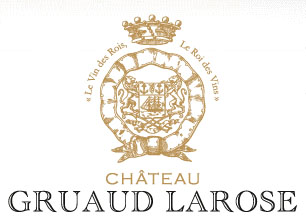
The Estate
The estate of Gruaud Larose in Saint-Julien has been divided up and joined together many times over the years. It was first owned by Joseph Stanislas Gruaud, a knight, followed by 2 other members of the Gruaud family, a judge and a priest. They combined their various properties in Bordeaux to create a 116 hectare winemaking estate which they named Fond Bedau. The judge and priest decided to bottle their own wines separately- the priest called his wine Chevalier de Gruaud, and the judge named his Abbe Gruaud.
Management of the property was handed over to Joseph Sebastian de La Rose in 1778. He added his name to the estate which was thereafter known as Gruaud Larose. In 1812, the family sold Gruaud Larose to Pierre Balguerie, Baron Jean Auguste Sarget, and David Verdonnet in order to pay off its debts. Soon after the sale, David Verdonnet died and so the estate was divided evenly between Balguerie and Sarget who managed the property together for 50 years.
Gruaud Larose was divided up yet again in 1867 and would remain separate until the 20th century. With his half of the estate, Baron Sarget bottled and sold the wine he produced under the name Gruaud Larose Sarget. He also began construction of the chateau on the property in 1875. The remaining portion of the original vineyard passed to the Bethmann family, who sold their wine under the names Gruaud Larose Faure and Gruaud Larose-Bethmann at different times.
In the early 1900s, the Cordier family acquired both the Sarget and Bethmann portions of the original estate and renamed the property Gruaud Larose once more. Jacques Merlaut, owner of Chateau La Gurgue, Haut Bages Liberal, Citran, Ferriere, and Chasse Spleen, purchased the property in 1997 and owns it to this day. Merlaut strives to make this Grand Cru Classé the most natural expression of wine by using organic compost and waste water treatment to protect and defend the grape viness.

Château Gruaud-Larose Saint-Julien 2ème Grand Cru Classé
Appellation: AOC Saint-Julien
Production Area: 82 hectares
Soil: Garonne gravel from the first quaternary, settled more than 600,000 years ago
Grape Varieties: Cabernet Sauvignon, Merlot, Petit Verdot, Cabernet Franc, Malbec
Plant Density: 8,500-10,000 vines/hectare
Average Age of the Vines: 46 years old
Viticulture: Integrated Pest Control (mechanical work, organic fertilization), Weather Station (phytosanitary protection), Prophylaxis (thinning out the leaves, removal of excess buds and shoots, green harvest). Heightening of the trellis. 100% of the surface is managed according to the principles of Organic and Biodynamic Agriculture.
Harvest: Manual harvesting, selection on a belt in the vineyard and double sorting at the harvest reception.
Vinification: Weighing of the crop, then plot selection in the tank (grape variety, terroir, age, …). The tanks are 40% wood and 60% cement (thermo-regulated tanks). Alcoholic fermentation with the addition of yeasts at temperatures between 31°C – 33°C. Daily tasting of each tank. Maceration lasts 21 – 35 days at adapted temperatures and according to the tasting. The grapes are pressed in pneumatic presses, then immediately transferred into barrels. Tasting and selection of four press wines among the barrels. Malolactic fermentation takes place 50% in barrels in a thermostatically controlled cellar, the rest in wooden tanks.
Aging: 16-18 months in French, fine grain, oak barrels, renewed by 30% every year to enhance the fruit. Medium toast.

Sarget de Gruaud-Larose Saint-Julien
Owner: Jean Merlaut
Vineyard Manager: Patrick Frédéric
Cellar Master: Philippe Carmagnac
Appellation: AOC Saint-Julien
Production Area: 82 ha/203 acres
Soil: Garonne gravel from the first quaternary, settled more than 600,000 years ago
Grape Varieties: Cabernet Sauvignon 57%, Merlot 31%, Cabernet Franc 7.5%, Petit Verdot 3%, Malbec 1.5%
Plant Density: 10,000 to 8,500 vinestocks/ha
Vineyard Management: Integrated Pest Control (mechanical work, organic fertilisation), Weather Station (phytosanitary protection), Prophylaxis (thinning out the leaves, removal of excess buds and shoots, green harvest). Heightening of the trellis. Manual harvesting, selection on a belt in the vineyard and double sorting at the harvest reception.
Average Age of the Vines: 25 years
Harvest: Weighing of the crop. Plot selection in the tank (grape variety, terroir, age…)
Vinification: In thermo-regulated tanks (60% cement, 40% wood). Yeast addition. Fermentation temperatures: 31°-33°C. Daily tasting of each tank. Pumping-over 2 volumes a day during fermentation according to tasting. Maceration for 21-35 days at adapted temperatures and according to the tasting. Running off; separation of the free-run-wine according to variety and tasting. Pneumatic presses; immediate transfer of the press wine into barrels. Tasting and selection of 3 press wines among the barrels. Malolactic fermentation, 50% in barrels in a thermostatically controlled cellar.
Aging: 14 months in French oak barrels (10% new, the rest 2-3 years old)
Alcohol: 12.7%
Total Acidity: 3.6
Tasting Notes: The color is brilliant and clear. The powerful nose reveals notes of roasting and leather. The second nose releases notes of jammy prunes. The mouth shows silky tannins, balance and freshness. Great aromatic persistency.


